| On our last day in Stockholm, we went
to visit Uppsala Cathedral and its Treasury.
|
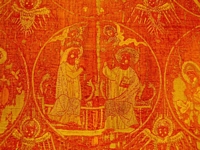 |
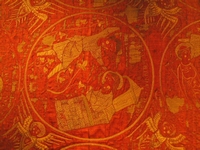 |
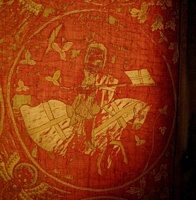 |
| The "Martyr Cope"
(1270), made from red silk (samite) with High Gothic embroidery in gold
and silk. The circles contain representations of martyrs and in the
centre, below the hood, (this circle) is the Coronation of the Virgin
Mary. (233kb)
|
Seraphim occurpy the spaces in
between. This circle is the representation of John the Baptist.
(328kb)
|
Circle containing St. George,
opposite St. Martin when worn. Parisian work, second half of the 13th
century. (233kb) |
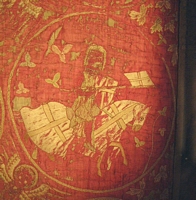 |
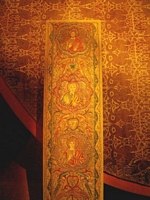 |
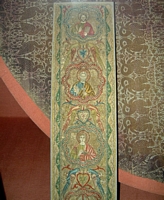 |
| Another shot of St. George on
the martyr cope. (244kb) |
Embroidered orphrey of a
chasuble belonging to the vestments of Nicholas Alloni from 1295.
(187kb)
|
All-over embroidery in gold,
silver, and multicolored silk. Medallions, birds, and various
ornaments in byzantinizing style standing out in bright contrasting colors
against the gold groun. (185kb)
|
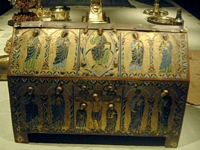 |
 |
 |
| Late 12th century, enameled and
gilt copper reliquary. The centre section (on the bottom) shows a
Calvary group with two angels visible above the arms of the
cross. (157kb) |
Above, on the sloping top of the
reliquary is a depiction of Christ in majesty, enthroned on the vault of
heaven, with the Book of Life on his knee and surrounded by the symbols of
the four evangelists. (148kb)
|
The ends are depicted with the
apostles, Peter and John. This end shows Peter (with his key).
(119kb) |
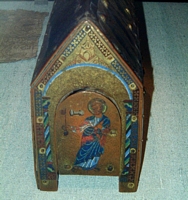 |
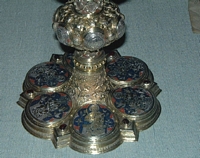 |
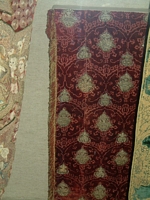 |
| Saint Peter, with his key, on
the end with no opening. (229kb) |
Gilt and enameled silver
chalice. On the foot are Christ and the apostles, Peter, John,
Andrew, Bartholomew, and Paul. (228kb)
|
Altar fontal of red silk velvet
with a pomegranate pattern, Italy, 15th century. Pieced together in
the 17th century. (184kb) |
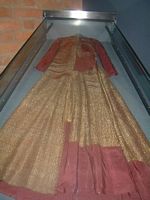 |
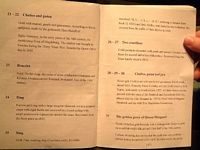 |
 |
| The golden gown as it is
currently displayed in Uppsala cathedral. (139kb)
|
The text from Uppsala Cathedral
about gown of Margarete. (64kb)
|
The remainder of the text about
the gown. (53kb) |
The text of the treasury guide says:
The golden gown of Queen Margaret
Gown of Italian gold brocade with a pomegranate design in gold on
a reddish-violet silk ground. First half of the 15th
century.
Carbon-14 dating has shown that the cloth was very probably woven
during the period 1403-1439. In other words, the gown could very
well have been made during the lifetime of Margaret, Queen of Denmark,
Norway, and Sweden. It is now the only preserved example of female
attire from the Middle Ages. For a long time, the gown was kept
near to Margaret's tomb in Roskilde Cathedral, but in 1659 it was taken
to Sweden as booty by Charles X. It was donated to Uppsala
Cathedral by the royal family in 1665.
|
 |
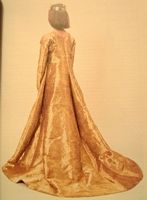
|
The reconstruction to the
left was made with fabric woven by The Boras School of Weaving, directed
by Christina Rinaldo, to create a gold brocade resembling the
original as closely as possible. |
| The original gown... (142kb) |
A reconstruction of the gown (142kb)
|
|
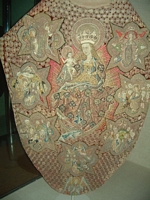 |
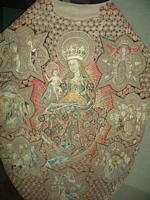 |
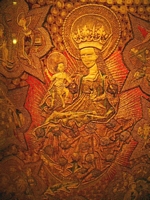 |
| A chasuble, ascribed to Albert
the Embroider, second half of the 15th century. (195kb) |
In a circle around Mary are
seven quatrefoils with scenes representing her seven joys: the
Annunciation, the Nativity, the Adoration of the Magi, the Resurrection
and Ascension of Christ, the Pentecost, and the Ascension and Coronation
of the Virgin. (204kb)
|
Embroidered all over with gold,
silver, silk and originally freshwater pearls, now lost. A depiction
of the Virgin portrayed as the Apocalyptic Woman surrounded by rays and
with the moon beneath her feet. (234kb) |
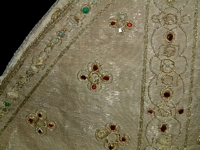 |
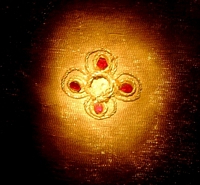 |
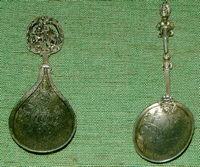 |
| A bishop's mitre from 1561,
embroidered with stones, used during the Coronation of Erik
XIV. (214kb) |
A close-up of the embroidery
with garnets. (80kb)
|
Two wine spoons. The left
is sliver gilt, from the 16th century, with a representation of St George
and the Dragon on the handle. The spoon on the right, from
1600, is silver gilt and engraved on the bowl is the Lamb of God.
(307kb)
|
 |
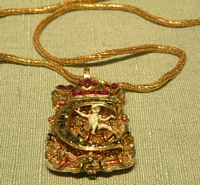 |
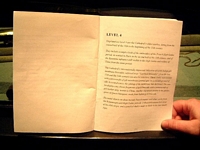 |
| Gold buttons, with a Moorish
pattern against a dark blue enamel background, from the burial costume if
John III. Recovered from his coffin. (195kb) |
A gold pendant with enamel and
gemstones. A "C" of table-cut diamonds below a crown of
rubies encircles an azzz in white enamel. Made by the goldsmith
Noriarth of Nürnberg in 1546. (156kb)
|
Info on the displays (50kb) |
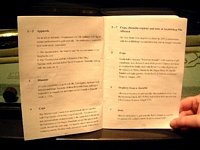 |
 |
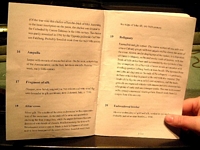 |
| Info on the displays .
(58kb) |
Info on the displays (77kb)
|
Info on the displays
(69kb) |
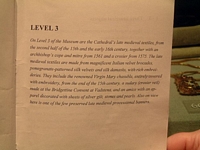 |
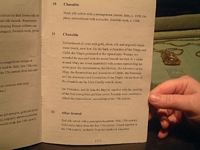 |
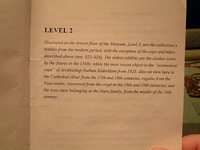 |
| Info on the displays.
(55kb) |
Info on the displays (57kb)
|
Info on the displays.
(47kb) |
 |
 |
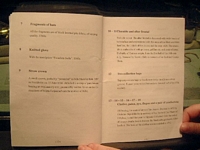 |
| Info on the displays
(59kb) |
Info on the displays
(57kb)
|
Info on the displays.
(49kb) |
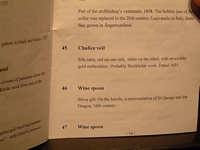 |
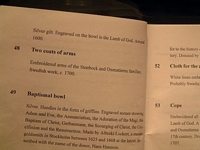 |
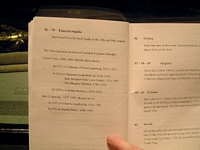 |
| Info on the displays
(42kb) |
Info on the displays (52kb)
|
Info on the displays
(53kb) |
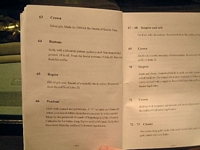 |
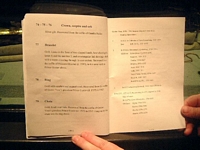 |
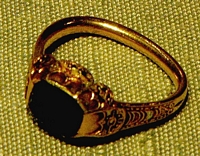 |
| Info on the displays.
(48kb) |
Info on the displays (53kb)
|
Gold ring with sapphire and
enamel work. Recovered from the coffin of Gustav Vasa's grandson
Prince Gustav, d. 1597. (126kb) |
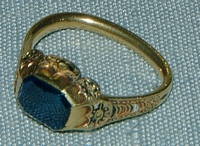 |
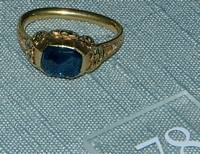 |
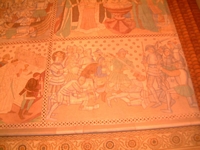 |
| A close-up of the ring.
(105kb) |
Another close-up, from a
different angle. (178kb)
|
The only remaining medieval
paintings in Uppsala Cathedral. (91kb) |
 |
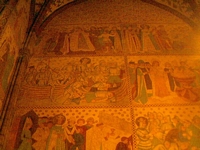 |
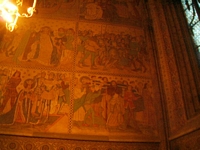 |
| The only remaining medieval
paintings in Uppsala Cathedral.. (336kb) |
The only remaining medieval
paintings in Uppsala Cathedral. (196kb)
|
The only remaining medieval
paintings in Uppsala Cathedral.. (144kb) |
 |
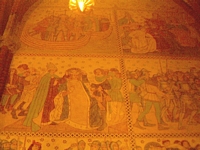 |
 |
| The only remaining medieval
paintings in Uppsala Cathedral.. (162kb) |
The only remaining medieval
paintings in Uppsala Cathedral.. (179kb)
|
The only remaining medieval
paintings in Uppsala Cathedral.. (122kb) |
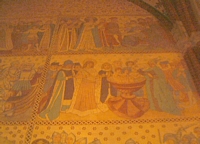 |
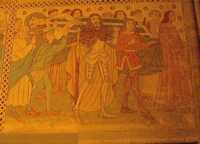 |
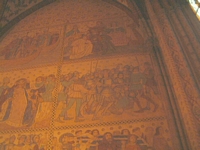 |
| The only remaining medieval
paintings in Uppsala Cathedral.. (162kb) |
The only remaining medieval
paintings in Uppsala Cathedral.. (184kb)
|
The only remaining medieval
paintings in Uppsala Cathedral.. (130kb) |
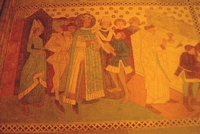 |
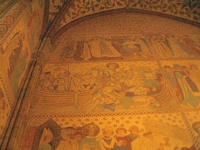 |
 |
| The only remaining medieval
paintings in Uppsala Cathedral.. (158kb) |
The only remaining medieval
paintings in Uppsala Cathedral.. (181kb)
|
The only remaining medieval
paintings in Uppsala Cathedral.. (175kb)
|
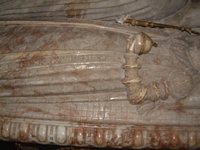 |
 |
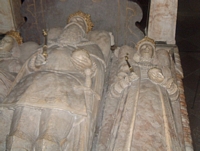 |
| An effigy of King Gustav Vasa's
wife, Margareta. (64kb) |
A details of Margerata's effigy.
(53kb)
|
Vasa and Margareta together
(with Vasa's other wife (Katharina) just visible. (139kb) |
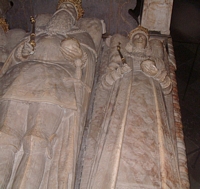 |
 |
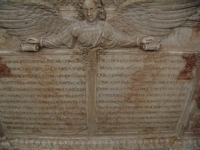 |
| Vasa and Margareta (64kb) |
Detail of Margareta's feet. (53kb)
|
Inscription by their tomb
(55kb) |
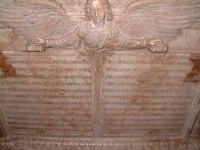 |
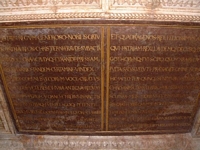 |
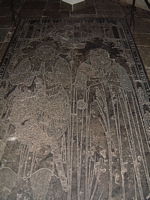 |
| Another shot of the tomb
inscription. (60kb) |
The inscription on the other end
of the tomb. (97kb)
|
An effigy brass in the floor.
(206kb) |
 |
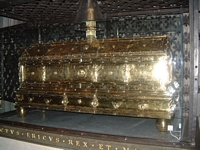
|
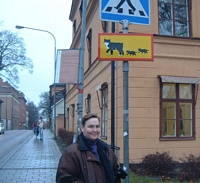 |
| another shot of the brass
(213kb) |
The relic casket of Saint (King) Erik Jedvardsson. The relic casket,
of embellished silver, was made in 1579. (160kb)
|
After we left the cathedral, we
saw this really cool sign... (134kb) |